ERUS-EAUN Robotics Meeting 2017: Refreshing insights from a comprehensive programme

Robotic surgery is, by far, one of the best and most advanced examples of combined competencies, forged together in theatre and moving forward as an effective team. It has pushed the boundaries of what was thought to be the known limit, just over a decade or so ago, to new heights and more is yet to come. Theatre nurses are intrinsic members of any effective robotic surgery team, thus their training and contribution to robotic surgery best practice, should not be underestimated.
As soon as ERUS— many months before the set date for the Bruges event— invited EAUN to put together a nursing meeting, work started immediately. No stonewas left unturned by Linda Söderkvist (robotic experienced nurse and EAUN Board Member) and Jane Petersson (RNFA, Denmark) who worked very hard to invite excellent speakers to address a wide range of salient topics. Also noteworthy was the undivided support from ERUS especially from Prof. Mottrie and Dr. Van Der Poel, who were instrumental for the success of the event.
Jane Petersson and Hilde Cammu (OR Nurse, Belgium) gave the welcome remarks and a quick outline of the programme, followed by my presentation, “Introduction to EAUN – now more than ever”. I highlighted the importance of coming together, getting organised, and moving forward in a concurred pathway to build upon what has been achieved. The EAUN is an ideal and well-placed platform from where all involved can contribute to a better harmonised evidence-based educational pathway.
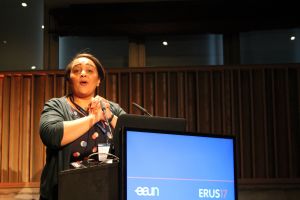
Ms. Dezita Taylor (UK)
Dezita Taylor (Lecturer in OR practice, Birmingham City University) quickly followed with her presentation titled “Human Factors in Robotic Surgery, team training and OR efficiency,” which was a welcoming, nononsense wake-up call on robotic surgery from a nursing point of view. She aptly took the audience through what, from a nursing perspective, can and will go wrong when one ventures into robotic surgery without the necessary training and coherent team build-up. Robotics is not something that one mentions on a Friday and wheel in theatre a DaVinci on a Monday. This has happened in the past, possibly still does with not so pleasant outcomes. Most of what she outlined must have rang home with many in the audience and yes, we are not alone in some predicaments, and yet there are solutions out there.
One excellent presentation was followed by another one, this time from Kate Furbur (Specialist OR Nurse, American Hospital of Paris). Her presentation, “Standardizing a European curriculum for nurses working with robotic surgery, a reality or a utopia?” was an apt subject to follow the previous one. Kate build her argument on better robotic nursing training based on her personal journey on the subject. Starting off some years back, from a less ideal situation where little training was available, she described her experience and pathway to a structured system and competence build-up, both clinical and academic. She also advocated the need for a structured and EU-wide defined robotic nursing training, not an easy task but an achievable one at that.
On a similar note but from a different take, was Jane Petersson’s presentation titled “Training and education to become RNFA”. Again, the need for a clear and structured robotic nursing training regime was covered extensively in this presentation with an outline of her work towards achieving it. The importance of a structured and mentored “hands-on approach” was well-described with practical examples of what has been achieved in her practice.
After a quick coffee break, again it was Dezita Taylor’s turn for another easy-to-relate to, eye-opening presentation, titled “Avoiding complications in Robotic Surgery”. This time round, she focused on standard operating procedures applicable to avoiding complications. Simple measures yet so effective, based on a rich experience build-up and careful analytic approach on what went wrong, why and control measures to avoid it.
The next presentation by Veronica Ramirez (OR nurse, MSc. Karolinska University Hospital Sweden) focused on a very specific yet very important topic complication avoidance. Her presentation titled “Position-related extremity symptoms after roboticassisted laparoscopic cystectomy” was built upon her evidence-based study focusing on this subject. With far reaching complications, if not well prepared for, she took us into an evidence-based approach, built upon data collected on the subject. The choice for the correct type of consumable system, plus patient positioning needs are part and parcel of what is required for the desired intervention outcome, thus avoiding long-lasting painful complications.
Insightful presentations
The day progressed with presentations from a non-nursing background, starting off with a two-part presentation by Prof. Erdem Canda (Ankara University Hospital, Turkey). Session one was titled “Port placement for robotic assisted radical prostatectomy & radical cystectomy; know your anatomy and how to avoid external and internal conflicts”. It was well presented, making constant references to actual complications and how to best avoid them by proper assessment and well-placed entry ports. The second part, was as interesting and well presented as the first, this time titled “Managing rectal injuries during robotic assisted surgery; what to do when things go wrong”. Again, this was backed up by extensive visual and pictorial references of situations one wouldn’t like to encounter, but inevitably will in the course of such interventions and how to rectify the situation.
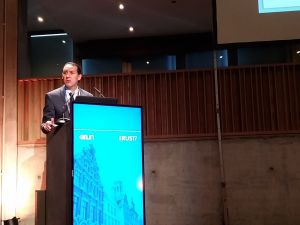
Dr. Victor Corona Montes (MX)
Another presentation followed that also focused on complication awareness and problem-solving. Dr. Victor Corona Montes (Mexico City, Mexico) discussed “Complications during robotic assisted urology surgery. What to do when something goes wrong” which followed the same high-level presentation seen during the day. Experienced clinical complications were well presented, with situations that any experienced robotic surgery team may be exposed to but will quickly react to if well trained. The need for a thorough drill regime for such situations was an important take home message to all present that day.
For the first and only time during this day, we had a very valid presentation from a “non-surgical” point of view. It was Dr. Geert Vandenbroucke (OLV Hospital, Belgium) who gave us a valuable insight on what theatre nurses seem to take for granted, with his presentation titled “Anaesthesia for patients undergoing robotic surgery – what all OR nurses and RNFA’s should know”. This presentation clearly underlined the fact that there are less visible aspects of robotic surgery but of which all team members must know due to their severity and implication to our patients.
After the lunch break, the afternoon session kicked off with Dr. Markus Aly (Karolinska University Hospital, Sweden) and his presentation “Radical
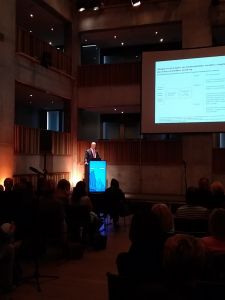
Dr. Markus Aly (SE)
prostatectomy: Which patients do we meet in the OR/ Latest research on the topic of PSA and diagnosing with fusion biopsies, factors deciding whether the patients will undergo surgery or have optional treatment. Handling postoperative complications”. The title actually says it all and it took the theatre nursing community into areas that they seldom are involved in, but nevertheless, need to understand and appreciate. It gave the audience an insight on what is the current and accepted norm and what may the next steps be as deciding factors for best treatment options.
Up next was Dr. Rafael Sanchez-Salas (Institute Mutualiste Montsouris, France) with “Bladder Cancer: Diagnosis and treatment. Factors deciding ilieal conduit or neobladder. Challenging case. Quality of life after surgery”. This was also an interesting presentation, excellently described and well presented with interesting insights going beyond that to which robotic surgery nurses would be directly involved in.
After a quick coffee break, Dr. Frederiek d’Hondt and OR Nurse Hilde Cammu (OLV hospital Belgium discussed “How to ensure patient ethics and patient safety during Live Surgery – what are the EAU standards”. We were invited to look into the ethics of live surgery broadcast with a burning question – “Are we being educated or entertained?”. For the first time for many in the audience, the procedure to follow for an ethically conducted live surgery, was well covered and aptly explained.
Challenging cases
Last but not least Mr. Ben Challacombe (Guy’s Hospital, UK) presented his “Kidney cancer: Diagnosis and Treatment. Focus on partial nephrectomy, challenging cases and surgical case”. This last presentation was also evidently well received by the audience, with well-placed visual references to difficult situations, what was done to overcome them and practical advice.
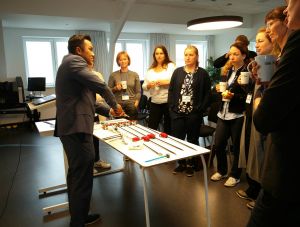
Mr. Harold Omana (UK)
This year’s ERUS-EAUN Robotic Nursing meeting had also a hands-on side to it. Again, with support of Prof. Mottrie, we had something special to offer to our nursing participants – a visit to ORSI Institute. We all hear about it but few of us ever get the opportunity to visit. Due to the large request, we were divided into groups. Half of the visit was dedicated to an introduction on difference between consumables used in the latest DaVinci models as opposed to the older generation with special reference to the de-docking technique. The second part was downstairs with the actual DaVinci systems where we had the opportunity to try out what we had been briefed on before. The newest hardware instalment from DaVinci was more intuitive, with respect to many aspects of the previous machine, and also offers more options and ease of user interface.
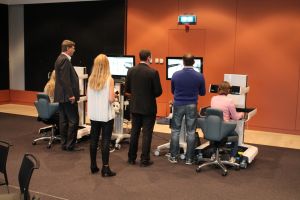
Hands-on Training
Another well received hands on session was from STAN Institute, again not possible without ERUS support. It covered the importance of communication skills that basically mimic those used in aviation between control towers and aviators. Simulation experience was also a great eye opener on how difficult it is to control such hardware. This becomes very evident in situations where one team member has a 3D view of the work area yet needs to interact with the rest who are looking at a 2D image without the benefit of depth perception.
From the post meeting feedback received, we can say that all the hard work paid back in dividends in the way of high-quality take-home new knowledge and greater appreciation of what it takes to be efficient, safe and competent in this ever-demanding sphere of high-end urology surgery.

